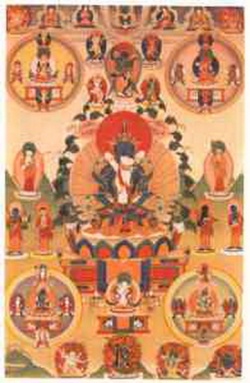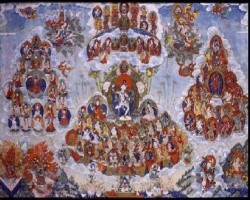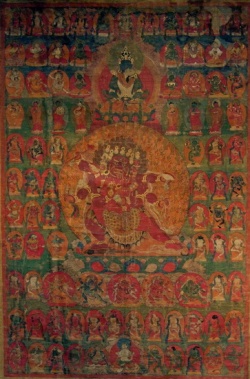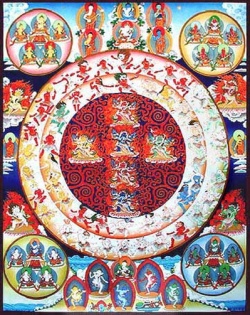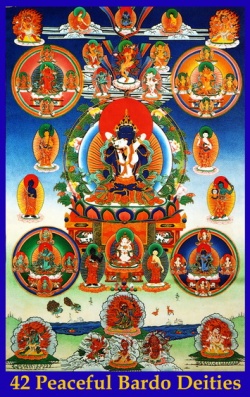The death ritual as guidance through the Bardo
"Secret Doctrienes of the tibetan book of the dead",
Detlef Ingo Lauf,
Shambala 1977
We can gauge approximately the size of a Tibetan Book of the Dead, the Bar-do thos-grol chen-mo for example, a few of whose seventeen volumes were published by Evans-Wentz, by considering that a translation of the entire work together with a commentary would be at least three times as large as Evans-Wentz' work. We could get the clearest idea of this by attending the readings and the death ceremonies themselves. For example, the relevant passages from the collective work "Kar-gling zhi-khro" take at least 14 days to recite, and can last up to 49 days. In the first 14 days, which are dedicated to the epiphany of the peaceful and wrathful bardo deities, the ritual recitations begin about six or seven o'clock in the morning and last about four hours, and they usually take the same amount of time again in the afternoon. The guidance of the dead person's awareness through the bardo is continuous for the first fourteen days, and the following fourteen days are given to explanations of the Srid-pa'i bar-do, the world of hell, and the bhavacakra.
Many preparations, which we shall now briefly describe, must be made for the setting up of the death ritual, the placing of the offerings on the shrine, and for the recitation of the rites.
The shrine or house altar, which is found in every Tibetan household, is furnished with the pictures and objects necessary for the bardo ritual. In addition to the usual images of the Buddha and other sacred figures or deities of Buddhism, one or two scroll paintings (T. Thang-ka) are hung up, depicting the peaceful and wrathful deities. Some pictures show the 42 peaceful deities, others the 58 wrathful ones, and yet others show all the deities together. If such pictures are not already in the house, they are brought by the monks from the monastery who have been invited to the recitation. Ceremonies for monks who have died are even more elaborate, and for the death rituals of important abbots and saints certain Mahakala dances are performed by monks in black robes and accompanied by special death music on drums. In these dances certain emanations of the terrible black tantric protective deity Mahakala or of the god of death, Yama, are invoked so that they may accompany the dead person on his way through the bardo.
Let us turn again to the normal death ritual in which the recitations are for a lay person who has died. The house altar is decorated with flowers, and bowls of water, sacrificial cakes (T. gTor-ma), incensed fruit are arranged in front of the ritual pictures. Then sometimes in addition to the usual candles, a set of 108 sacrificial lamps is used, made of brass, copper, or silver, or else made out of dough and filled with butter. Another possible addition to the symbolic arrangement of the altar is the placing of various groups of Buddhist signs, made out of wood or brass (or silver), in rows in front of the sacrificial bowls. Included among these might be the offerings of the five senses (T. 'Dod-yon sna-Inga), the eight Buddhist auspicious signs (S. astamahgala; T. bKra-shis rtags brgyad), the eight sacrificial gifts that bring good fortune (S. astadravyaka; T. rDzas brgyad), and the seven symbols of the royal rulers (S. saptaratnani; T. Rin-chen sna bdun). Also indispensable is the great rice mandala as the symbolic offering of all precious gifts of this impermanent world to the buddhas.
First, the monks (at least two or more) arrange'the ritual objects on the narrow tables in front of which they sit. In the tantric ritual for the bardo deities these are the vajra (T. rDo-rje), the ritual bell (T. Dril-bu), the small hand-drum (S. damaru; T. cang-te'u) of wood or skull-bone with hide stretched on both sides, the pair of small cymbals (T. Ting-shags), the tantric kapala (T. Thod-pa), a bowl of yellow sacrificial rice, and the ritual jug for consecrated water (T. Khrus-bum). This vessel of sacred water is of special symbolic significance for the introduction into the teachings concerning the visions of the deities of the Tibetan Book of the Dead. In the upper opening of the vessel rests a crown of peacock feathers on a stick, which is used as a sprinkler. For the death ritual a small picture of the blue Adibuddha Samantabhadra (T. Kun-tu bzang-po) with his white counterpart, or prajna, is attached to the front side of these feathers. This Buddha is the most important figure in the mandala of the bardo deities, being the primordial image of all emanations from the dharmadhatu sphere of the pure dharmakaya.
A final indispensable part of every bardo ritual is the small cards with pictures of the deities of the Book of the Dead, which the monk holds in his hand. With these cards he guides the dead person's awareness, and symbolically that of all the participants in the ritual, through the realm of the bardo. The cards (T. Tsa-ka-li) are usually only half the size of a postcard, have a red border, and portray in separate groups all the deities in an order corresponding to the Book of the Dead. According to the number of deities pictured together on one card and to the way they correspond to the structure of the appropriate Book of the Dead, there are various sets of these cards containing from 50 to 80 of them. The small cards are often true masterpieces of Tibetan painting, since often as many as 28 detailed icons of deities may be painted in a very small space, care being taken to include all the appropriate colors and attributes. We are also acquainted with similar cards for the death rituals of the ancient Tibetan and pre-Buddhist Bon religion. There too, they are used to guide the dead person through the realms of the bardo, the cards being shown and explained one at a time during the ritual. Connected with the showing of the cards, which the presiding lama holds up at certain points in the text, are the initiations for the dead person to be described below.
However, without the presence of the dead person the recitation of the Book of the Dead cannot begin. It is true that after his burial (or cremation) he is no longer physically present, but in his place is a picture of him, called his sByang-bu (also mTshan-sbyang, Byang-bu, or sByang-gzhi). This usually takes the form of a Tibetan woodblock print but can also be drawn by one of the monks on white paper. Figures 9—13 show five different kinds of Tibetan block prints, and two similar examples can be found in Evans-Wentz73 and in Schlagintweit.74 The prints are different for men and for women. We see first a dead man symbolically represented in a praying attitude kneeling on a lotus with a lotus blossom in his hand (fig. 10).
He is sitting under a canopy of honor, and on the altar to the side we see an altar lamp (T. Mar-me), a gTor-ma (sacrificial cake), and a bowl of rice. These three objects play a special role in the death ritual by representing the six lokas. The next picture shows a woman with folded hands under the canopy of honor kneeling on a lotus. She too holds a lotus blossom in her hand. The Tibetan inscription reads: "She who has left life." The other two pictures show a mantric syllable standing for the dead man from the ritual for the Srid-pa'i bar-do. The syllable is Nr, the mantra for the human world. It stands on the lotus throne under the canopy. In the case of a dead man one can see in the center of the Nr the mantric syllable Hum, in the case of a woman, the syllable Vam.
For the dead man the reverse side of the Byang-bu (see fig. 12) bears an inscription invoking the god of death, Yamantaka, as a protective deity. The gap in the text is to be filled by the dead person's name. The text reads: "May the deceased, (Name), through the assembled deities of the Sri-Vajrabhairava (another name for Yamantaka) be freed from all his failings and taken to the realm of the buddhas." The other Byang-du, for a dead woman, is quite similar, but on the reverse side the inscription invokes the tantric Dakini Vajrayogini (T. rDo-rje rnal-'byor-ma) as the protective deity and guide through the bardo. The text reads:
"May the deceased, (Name), through the venerable Dakini Vajrayogini, when freed from and purged of all failings, be taken to the heavenly realm" (fig. 13). We see from these prints that various forms of representation are used in Byang-bus. These pictures are attached to a stick for the rite and placed on a lotus made from clay or dough. A small canopy of material of five colors is placed over the picture. The use of the Byang-bu in the ritual will be explained in chapter III in our discussion of the six Buddhas.
The most interesting and dramatic part of the whole death ritual is the initiation and conversation with the dead person through his image, the Byang-bu. In several verses the deceased is called upon by the lama and entreated to appear from the bardo beyond and to take his place in the picture that has been prepared for him, so that he can take part in the ceremony and its blessings Thus the Byang-bu becomes the dead person who has become present again and who is now symbolically beginning the journey through the six worlds. At the end the picture is burned, symbolizing a second death on a higher, ritual plane, whereby the earthly death of physical decay is overcome. We shall return to this ritual later, since we must here maintain the character of a general overview.
Let us begin now with the introductory contemplation of the "mandala of the most sublime magical-illusory peaceful and wrathful deities." We shall determine the general sequence of the initiations according to a particular work (dBang-bskur ‘bring-po ‘gro-drug rang-grol) from the Tibetan Book of the Dead. The deities are also called "the most venerable assembly of the hundred peaceful and wrathful deities" (T. Zhi-khro dam-pa rigs brgya), and they are usually divided into two large groups. In the heart center (T. sNying-ga'i 'khor-lo) the 42 peaceful deities appear in the midst of a bundle of light rays, and in the "white couch" of the skull the 58 wrathful deities arise from flaming rays. In addition (although not according to all texts) the five Vidyadharas with their Dakinis (ten deities altogether) appear in the throat center (T. Longs-spyod 'khor-lo), and according to the tradition of the bKa' rdzogs-pa chen-po scriptures the five Jnanadakinis (T. Ye-shes mkha-'gro Inga) appear in the navel center (T. ITe-ba'i 'khor-lo) and the wrathful blue Vajrakila-Heruka appears with his Prajna in the perineum (T. gSang-gnas 'khor-lo). From these, in the visions in the Chos nyid bardo (the bardo of reality experience), arise the three great mandalas of the bardo deities:
1. The hundred peaceful and wrathful deities
2. The 110 deities including the Vidyadharas
3. The 117 deities of the supplemental bardo cycle
We encounter all three groupings in the scriptures as well as in the iconographic paintings for the Tibetan Book of the Dead. In agreement with our text we shall now put the initiations of the first grouping together with the hundred deities of the bardo mandala, and these should then serve, as the consecrations of the deities, or rather in the name of the deities (T. Lha-dbang), to transpose all the psycho-physical centers of the human body ut of the state of profane ignorance into the condition of perfect knowledge. In all initiations the Tibetan lamas use the jug of consecrated water with the peacock feathers and the picture of the blue Adibuddha Samantabhadra (Yab-Yum). Firstly, the dead person is summoned to his Byang-bu by the lama performing the ceremony, who lifts up the jug (S. kalasa) and says that, although the outer form is that of a jug, yet the great heavenly dwelling place of the deities is within it. Then he addresses the dead person: "Hum! In the kalasa of the Buddha Samantabhadra (in unity) with his Prajna dwells the divine assembly of the victorious peaceful and wrathful deities. In being blessed, O dead person, may you receive the deities' initiation."
Thus the Samantabhadra-abhiseka (T. Kun-bzang yab-yum dbang) leads into the series of the thirteen important initiations, during the course of which all knowledge about the visionary deities and the symbolic significance of their groupings is made manifest. There is a further series of consecrations, which we cannot, for the sake of clarity, consider here. The first consecration concerns the representation of the immeasurable Adibuddha Samantabhadra in the dharmakaya, whose illuminated vision belongs to the 'Chi-kha'i bar-do.
Therefore the Adibuddha, an in itself unrepresentable idea of the dharmakaya, is not counted among the visions of the Chos-nyid bar-do. He is the mystical father and medium of all the bardo deities. All the other consecrations except one have to do with the sambhogakaya, i.e., with the visions in the Chos-nyid bar-do of reality-experience. There then follow the initiations for the five Tathagatas or transcendent Buddhas (T. Rigs Inga yab Inga'i dbang), in order to purify the realm of the five skandhas, and then the consecration for the knowledge of the five female counterparts of the Buddhas (T. bDe-gshegs yum Inga'i dbang), in order to clarify the five elemental realms. Then come the initiations of the eight Mahabodhisattvas and their Dakinis, for the purification of the eight functions of consciousness and their realms of activity. The next consecration, for knowledge of the six Buddhas as incarnations of Avalokitesvara, is the only one carried out in the plane of the nirmanakaya (T. sPrul-sku thub-pa drug-gi dbang). With this consecration the six vices which cause people repeatedly to arrive at karmically conditioned rebirth are said to be overcome. At the end of the consecrations for knowledge of the peaceful deities stand the two for the four male and the four female Guardians of the mandala, which help the dead person to attain the "four limitless ultimates" and the "four divine boundless states."
Then begin the initiations for the wrathful deities, starting with the one for the powerful Mahasri-Heruka (T. dPal che-mchog), the lord of the "blood-drinking deities" (T.Khrag-'thung rab-'byams dbang). He is the extremely wrathful emanation of the peaceful Adibuddha Samantabhadra. With a significance corresponding to those for the peaceful deities, except now in the powerful (T. Drag-po) form of the tantric deities, there follow the initiations for the five wrathful Buddha-Herukas, their five Dakinis, for the eight Keurima and the eight Phra-men-ma deities, the four animal-headed female Guardians of the second mandala, for the purification of the four places of birth, and finally for the 28 powerful theriomorphic Dakinis, in order to overcome any remaining false ideas or chimeras of consciousness. We shall give an explanatory overview of this central part of the important initiations, in which the Adibuddha Samantabhadra stands in the dharmakaya above all deities as the experience of the clear light in - the bardo of the moment of death. Only the sequence has been altered in the list (see table 9) in order to make clear the correspondences with the psychic centers.
